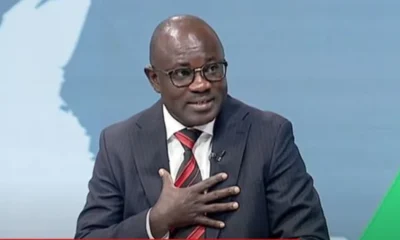World News
LA and San Diego Schools to Go Online-Only in The Fall
Published
5 years agoon
[ad_1]
SACRAMENTO — California’s two largest public school districts said on Monday that instruction would be online-only in the fall, in the latest sign that school administrators are increasingly unwilling to risk crowding students back into classrooms until the coronavirus is fully under control.
The school districts in Los Angeles and San Diego, which together enroll some 825,000 students, are the largest in the country to abandon plans for even a partial physical return to classrooms when they reopen in August.
The decision came as Gov. Gavin Newsom announced some of the most sweeping rollbacks yet of California’s plans to reopen. Indoor operations for restaurants, bars, wineries, movie theaters and zoos were shut down statewide on Monday, and churches, gyms, hair salons, malls and other businesses were shuttered for four-fifths of the population.
“There’s a public health imperative to keep schools from becoming a petri dish,” said Austin Beutner, the Los Angeles school district’s superintendent.
The California decisions are the latest blow to President Trump’s push to fully reopen schools across the country this fall in order to get the economy moving by enabling parents to return to workplaces. Districts, parents and teachers have struggled to maintain the education of tens of millions of K-12 students while keeping them and their teachers healthy and safe.
At the White House, Mr. Trump denounced the decision in Los Angeles, arguing that schools should resume because children wanted to attend.
“Schools should be opened,” Mr. Trump said. “You’re losing a lot of lives by keeping things closed.” It was not clear what he meant, since public health experts say the virus spreads quickly in poorly ventilated, closed areas, the condition of many American schools.
Across the country, school districts are taking a patchwork approach to reopening.
New York City, the nation’s largest school district, announced last week that it would provide several days per week of in-person learning, with students working online from home the rest of the time. Seattle has also announced a hybrid model that is emerging as popular nationwide, among both large and small districts. Chicago, the nation’s third-biggest system, has not yet announced its reopening plan.
But in cities where the virus has continued to rage, efforts at compromise solutions have increasingly proven unworkable — a shattering realization for families that have strained for months to cobble normalcy out of a situation that is pitting their children’s development and education against parental livelihoods and household health.
Mahogany Taylor, a 39-year-old mother of two and the president of the San Diego Unified Council of PTAs, said the loss of in-person instruction was particularly destructive for elementary school students — many of whom cannot type — and for low-income students, who often lack internet access, and who make up nearly 60 percent of San Diego Unified’s students.
At the same time, Ms. Taylor said, a districtwide survey showed that 40 percent of parents already were planning to insist on remote instruction. “We obviously believe that school is the best place for kids,” she said, “but we also want them to be safe.”
All across the nation, school officials are trying to balance safety against learning losses. Initial research showed that during the first round of school closures, American children were set back, on average, by seven months in their reading and math learning, with children from low-income families, and students of color, experiencing even bigger losses.
Still, district leaders in Los Angeles and San Diego said, California was not in a position to reopen schools.
“Those countries that have managed to safely reopen schools have done so with declining infection rates and on-demand testing available,” the statement said. “California has neither. The skyrocketing infection rates of the past few weeks make it clear the pandemic is not under control.”
Mr. Beutner, whose district is the nation’s second largest, said in an interview that schools “can’t just tap our heels together” like Dorothy in “The Wizard of Oz” and “pretend it’s appropriate to bring people back” despite “skyrocketing” rates of new infections.
California’s death toll from the coronavirus rose to more than 7,000 over the weekend, with 7.4 percent of test results coming back positive over the past two weeks, even as testing has ramped up to more than 100,000 tests a day. The state’s watch list of counties where the virus has surged, which has flagged Los Angeles and San Diego Counties, includes 30 of its 58 counties.
For the time being, Mr. Beutner said, the Los Angeles district will maintain the online instruction it has been providing since its 700,000 students and 75,000 employees were sent home in mid-March. He said the decision would be revisited when local infection rates have been sufficiently lowered and public health authorities have put into place adequate testing and contact tracing systems.
“It’s disappointing,” he said. “But at the end of the day, we’ve got to make sure everyone’s safe.”
Many parents, students and teachers are still waiting to learn whether their districts will open this fall.
On Monday night, the Atlanta Public Schools Board of Education is expected to adopt a plan for full-time remote learning for at least the first nine weeks of the school year.
Nashville originally planned to open five days a week, but rolled that back on July 9, citing the rising number of local coronavirus cases.
Miami-Dade County Public Schools is currently asking parents to choose between full-time remote learning and a “schoolhouse model,” which would be in-person two to five days a week and online the rest of the time, depending on the number of students enrolled in a building and the amount of space available for social distancing.
Schools in New York will only reopen if the state can keep the virus under control, Gov. Andrew M. Cuomo said on Monday.
The governor said he would allow reopenings only in regions of the state that have daily infection rates under 5 percent over a two-week average. Regions with infection rates over 9 percent over a one-week average will not be allowed to open schools or will automatically have their schools shuttered.
New York City, which has maintained an average infection rate of 1 to 2 percent, is on track to partially reopen in September.
All the plans, district leaders say, are subject to change at a moment’s notice, as public health guidance shifts or as governors make statewide decisions.
Indeed, with the pandemic still raging across much of the country, it has become clear that improving the quality of online learning will be at least as important in the coming months as dealing with the logistics of reopening physical schools.
Several other large California districts, including Santa Clara, Oakland and San Bernardino, have already announced that they will stick, at least for the foreseeable future, with full-time remote instruction, and the state’s politically powerful teachers’ unions also have come out against a return to in-person classes.
The Los Angeles teachers’ union called last week for campuses to remain closed and for learning to be fully remote when the district resumes classes on Aug. 18, saying Mr. Trump’s reopening push was part of a “dangerous, anti-science agenda.” In an informal survey of 18,000 United Teachers Los Angeles members that was released on Friday, 83 percent agreed that campuses should not physically reopen.
And the state’s largest teachers’ union wrote Mr. Newsom — a Democrat elected with their support — a sharply worded letter last week expressing concern “that politics are being played with the lives of children and the educators who serve them.”
“It is clear that communities and school districts have not come close to meeting the threshold for a safe return to in-person learning, even under a hybrid model,” the 310,000-member California Teachers Association wrote.
Some $13.5 billion went to K-12 education from the federal relief package passed in March by Congress. But education groups and school districts estimate that schools will need much more money to safely reopen, and with the economic impact of the pandemic having depleted many local and state budgets, it is unclear where it will come from. The Trump administration has alternately threatened to cut funds to school districts that fail to fully reopen and reward districts that do.
As recently as late last week, leaders in San Diego Unified were promoting their plan to reopen five days a week, in person, for all students whose families chose that option. But the district had also warned that the health, sanitation and educational costs of reopening physical classrooms safely were so steep — a minimum of $90 million for the coming school year — that they would not be able to do so without a significant infusion of federal dollars.
At the same time, the district’s teachers’ union was arguing that reopening during an alarming increase in coronavirus cases was unwise, and would put teachers’ health at risk.
The superintendent, Cindy Marten, had been working with education leaders across the country to lobby the Senate to pass a second stimulus package for schools.
Ms. Marten said the district had not given up on the possibility of reopening physically if infection rates get down to a safe and manageable level, and even moved forward over the weekend with plans to buy $11 million worth of masks and other protective equipment. But the state’s current infection levels, she said, “should make it clear to everyone that the virus is not under control.”
“School districts need to be able to walk and chew gum at the same time,” Ms. Marten said. “We must both plan for a physical reopening while taking measures to keep our communities safe.”
Shawn Hubler reported from Sacramento and Dana Goldstein from New York. Eliza Shapiro contributed reporting from New York.
[ad_2]
Source link
Comments
You may like

Residents Accuse CDF Officials of KSh 2,000 Bursary Bribes – MP Zaheer Jhanda Under Fire in Nyaribari Chache

Roads in Kitutu, Colleges in South Mugirango, Rice and Beans in Nyaribari Chache: Is This MP Zaheer Jhanda’s Version of Development?

Son of Siaya or Son of Busia? David Ochieng’s Politics of Convenience Exposed

Exposing the Scandals of James Orengo in Siaya and Lands Ministry.

Exposing the Scandals of James Orengo in Siaya and Lands Ministry.

Son of Siaya or Son of Busia? David Ochieng’s Politics of Convenience Exposed

Roads in Kitutu, Colleges in South Mugirango, Rice and Beans in Nyaribari Chache: Is This MP Zaheer Jhanda’s Version of Development?

Residents Accuse CDF Officials of KSh 2,000 Bursary Bribes – MP Zaheer Jhanda Under Fire in Nyaribari Chache

Wantam Protests Hit Ugunja as CS Opiyo Wandayi Loses Support, Youths Invite DCP Led by Rigathi Gachagua

South Sudan at the Brink: How Corruption Tightens Its Grip on a Rare Working Institution

Chepterit Comes Alive During SportyBet Kenya Gifts Motorbike to Loyal Fans

Nest Lounge Narok Under Scrutiny as KRG The Don Shooting Incident Triggers Government Silence and Maasai Community Outcry

Why the Sh323.8 Billion Kenya US Health Agreement Is Raising Data Privacy Questions

Betty Bayo’s Mother Seeks DPP Inquest Over Daughter’s Death
Trending
-

 General News1 week ago
General News1 week agoResidents Accuse CDF Officials of KSh 2,000 Bursary Bribes – MP Zaheer Jhanda Under Fire in Nyaribari Chache
-

 General News4 days ago
General News4 days agoRoads in Kitutu, Colleges in South Mugirango, Rice and Beans in Nyaribari Chache: Is This MP Zaheer Jhanda’s Version of Development?
-

 Politics4 days ago
Politics4 days agoSon of Siaya or Son of Busia? David Ochieng’s Politics of Convenience Exposed
-

 General News2 days ago
General News2 days agoExposing the Scandals of James Orengo in Siaya and Lands Ministry.
